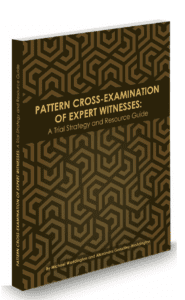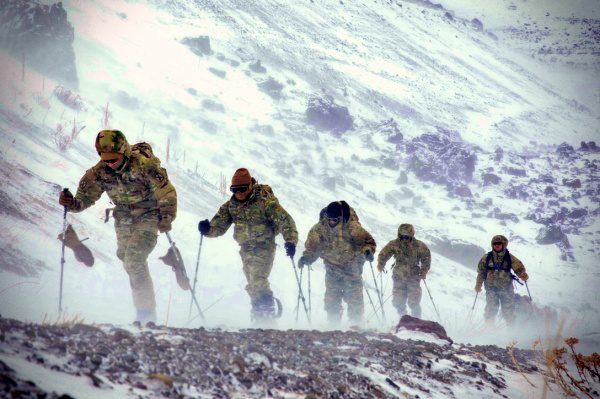Cross-Examination Techniques & Sample Cross-Examination Questions
Pattern Cross-Examination for DNA and Biological Evidence
 In a criminal trial, cross-examination of the prosecution’s forensic expert may make the difference between victory or defeat. More and more, aggressive prosecutors are relying on forensic psychiatrists, toxicologists, and other experts to help obtain convictions. Some expert witnesses will do whatever it takes, including misapplying scientific research to bolster the prosecution’s case. For the sake of justice, defense lawyers must be able to cross-examine and nullify forensic experts effectively.
In a criminal trial, cross-examination of the prosecution’s forensic expert may make the difference between victory or defeat. More and more, aggressive prosecutors are relying on forensic psychiatrists, toxicologists, and other experts to help obtain convictions. Some expert witnesses will do whatever it takes, including misapplying scientific research to bolster the prosecution’s case. For the sake of justice, defense lawyers must be able to cross-examine and nullify forensic experts effectively.
In the second Bill Cosby trial and Harvey Weinstein’s New York trial, both sides prominently used forensic experts. In these cases, counterintuitive victim behavior experts played a vital role in the prosecution’s trial strategy. This book will help defense lawyers neutralize such experts.
PATTERN CROSS II: BOOK REVIEWS |
 “Pattern Cross-Examination of Experts is an easy-to-follow, practical guide to arm the advocate against an often intimidating adversary-the opposing expert. This inspired and meticulously crafted how-to guide more than levels the playing field by presenting an easy and consistent path to an effective dismantling of the expert’s opinion in virtually every context.” “Pattern Cross-Examination of Experts is an easy-to-follow, practical guide to arm the advocate against an often intimidating adversary-the opposing expert. This inspired and meticulously crafted how-to guide more than levels the playing field by presenting an easy and consistent path to an effective dismantling of the expert’s opinion in virtually every context.” – Jacquie Goodman, Law Offices of Jacqueline Goodman (Fullerton, CA)
|
 “The power of the techniques in this book are exceeded only by the voluminous examples of succinct questions on just about every key topic you will encounter in trial. This is a step-by-step playbook to effective lawyering when you are in battle.” “The power of the techniques in this book are exceeded only by the voluminous examples of succinct questions on just about every key topic you will encounter in trial. This is a step-by-step playbook to effective lawyering when you are in battle.”– Brian Bieber, GrayRobinson Attorneys at Law (Miami, FL)
|
Learn the Cross-Examination Techniques of the Pros
NACDL’s Pattern Cross-Examination of Expert Witnesses will assist criminal defense practitioners in scoring points when cross-examining forensic experts. This resource contains thousands of cross-examination questions that will help defense lawyers cross-examine challenging witnesses, using scientific research, without having to reinvent the wheel with each new case. It contains pattern questions that can be used to dominate prosecution experts and level the playing field at trial, and the sample cross-examination techniques and cross-examination questions can be easily modified and used in a variety of cases. The questions provided serve as a starting point. Because every case is different, the cross-examiner should modify the questions based on the facts of their case. This Trial Guide is not a textbook on the theories of cross-examination. Instead, it provides sample questions based on fact patterns commonly encountered when dealing with forensic experts in a variety of trials.
There are hundreds of citations included for scientific research, so lawyers can readily impeach opposing experts using the learned treatise exception.
Click to Download Sample Cross-Examination from this book
Packed with cross-examination examples, this book will assist in the cross-examination of:
-
- cross-examination of forensic psychiatrists/psychologists;
- cross-examination of forensic toxicologists;
- cross-examination of strangulation experts;
- cross-examination of law enforcement;
- cross-examination of social workers;
- cross-examination of experts in child abuse, assault, and sex crimes.
Includes Sample Cross-Examinations for:
CHAPTER 1: Dealing With Hostile Witnesses
CHAPTER 2: Counterintuitive Victim Behavior
CHAPTER 3: Alcohol: Memory & Consent
CHAPTER 4: Memory & Perception
CHAPTER 5: False Confessions
CHAPTER 6: Child Memory
CHAPTER 7: Confabulation (Memory Error)
CHAPTER 8: False Allegations of Sexual Assault
CHAPTER 9: Borderline Personality Disorder
CHAPTER 10: Strangulation
CHAPTER 11: Bruising & Dating Bruises
CHAPTER 12: Cognitive Dissonance & Sexual Assault
Cross-Examination Techniques
- Pattern Cross-Examination for Sexual Assault Cases
- Pattern Cross-Examination of Expert Witnesses
- Pattern Cross-Examination for DNA and Biological Evidence
Sample Cross-Examination Questions from the Book
These can be used for civilian or military sexual assault cases
Sample Cross-Examinations on Blood Alcohol Content
Sample Cross-Examination Point: You Are Guessing the BAC
Q: You testified that the victim’s blood alcohol concentration was approximately .21 when she left the bar?
Q: There was no blood test done in this case?
Q: There was no breathalyzer test done in this case?
Q: A blood and breath tests are accurate at determining blood alcohol content?
Q: Your opinion of .21 is simply a guess?
Q: You don’t know her actual BAC?
Q: Your BAC guesstimate is based on numerous factors?
Q: One of the factors is the time period that she was consuming alcohol?
Q: That is important because the body processes alcohol over time?
Q: Another factor is how much alcohol was consumed?
Q: Another factor is the strength of the alcohol?
Q: Another factor is her sex?
Q: Another factor is her body weight?
Q: Here, the victim weighs 155 pounds?
Q: You were not there at the bar?
Q: You were not at the house where the sex occurred?
Q: You did not witness her drinking?
Q: You don’t know for sure when she started drinking?
Q: We heard different variations of when she started to drink?
Q: One witness said the drinking started at 7PM?
Q: Another witness said the drinking started at 9PM?
Q: The victim said it started at 5PM?
Q: You don’t know for sure when she stopped drinking?
Q: We heard different variations of when she stopped to drink?
Q: The victim said she thinks she left the bar at midnight?
Q: But, she was not sure?
Q: She had her last drink right before she left the bar? Another witness said she left the bar at 2PM?
Q: That witness testified that the victim was kicked out of the bar at 2PM, after the bar closed?
Q: So in terms of the time period that she was consuming alcohol, we have her drinking from 5PM to 2AM?
Q: That is 9 hours?
Q: In a different version, we have her drinking from 9PM to 12AM?
Q: That is 3 hours?
Q: That is a significant difference in terms of calculating BAC?
Q: In this case, you don’t know the exact time frame that she was consuming alcohol?
Q: In this case, you don’t know exactly how many alcoholic drinks the victim consumed?
Q: The victim said she consumed 4 beers and 4 shots?
Q: That is approximately 8 drinks?
Q: In her initial statement to the police, she said she had 6 drinks?
Q: 3 beers and 3 shots?
Q: The victim’s best friend said that the victim drank 10 drinks?
Q: So in terms of drinks, we have a range of 6 to 10 drinks?
Q: Nobody knows the exact number?
Q: So you picked one in the middle and went with 8 drinks?
Q: In terms of time, you picked one in the middle and went with 6 hours?
Q: That is not very scientific is it?
Q: You realize that my client’s life is on the line here?
Q: You understand that his future and freedom may depend on how intoxicated the victim was?
Q: So your expert opinion is important in this case?
Q: In your expert opinion, to a reasonable degree of medical certainty, you do not know her blood alcohol content?
Q: In your expert opinion, to a reasonable degree of medical certainty, you do not know if she was capable of consent?
Q: Let’s look at the range of the victim’s potential BAC’s for a 155 pound woman?
Q: If she had 6 drinks over a course of 9 hours, she would have a BAC of approximately .08?
Q: That is not close to blacking out?
Q: People normally experience a black out when their blood alcohol concentration is between .20 and .23?
Q: That is not close to passing out?
Q: People normally pass out when their blood alcohol concentration is .30 or higher?
Q: Let’s go with the victim’s second story, that she had 8 drinks?
Q: If she had 8 drinks over a course of 9 hours, she would have a BAC of approximately .16?
Q: If we shorten the timeline, and say she had 6 drinks over a course of 7 hours, she would have a BAC of approximately .12?
Q: If we shorten the timeline, and say she had 8 drinks over a course of 7 hours, she would have a BAC of approximately .20?
Q: The only number in this blood alcohol equation that we do know is her weight?
Q: The other numbers a speculative?
Q: But the bottom line is, you don’t know for certain how many drinks she drank?
Q: You don’t know for certain how long she was drinking?
Q: You gave the jury a possible blood alcohol level?
Q: That level is based on speculation?
Q: Her BAC could have been .08?
Q: It could be less than .08?
Q: Her BAC could have been .12?
Q: Her BAC could have been .16?
Q: Her BAC could have been .20?
Q: It could have been more?
Q: There is too much missing date to know her BAC to a reasonable degree of medical certainty?
Q: Without an accurate blood or breath test, the jury will never know her actual BAC?
Sample Cross-Examination Point: You Cannot Calculate BAC Without a Timeline
Q: You testified that the victim’s blood alcohol concentration likely peaked at .21?
Q: Th is based on her memory that she had 8 drinks at the bar?
Q: She drank from 6PM to midnight?
Q: She weighed 155 pounds?
Q: Later that night, she had sex with the defendant?
Q: You don’t know what time they had sex?
Q: Let’s talk about the timeline that we heard in the testimony?
Q: The victim stopped drinking at the bar?
Q: At the latest, she left the bar at 12AM?
Q: She took an Uber to her house?
Q: Her house was in La Jolla?
Q: It took her 30 minutes to get home?
Q: She does not know when she went to sleep?
Q: She thinks that she went to bed around 2AM?
Q: Some time in the middle of the night, she says that the defendant sexually assaulted her?
Q: She said that she was too drunk to resist?
Q: When the sex occurred, it was dark outside?
Q: She does not know what time they had sex?
Q: The sex occurred some time between 2AM and sunrise?
Q: Sunrise was around 7AM on that day?
Q: There is a 5 hour window in which they had sex?
Q: From the time she stopped drinking, her body began to process alcohol?
Q: From 12AM to 7AM, her body would have processed much of the alcohol?
Q: Her level of intoxication would have decreased as the night went on?
Q: At 2AM, she would have been more sober than at 12AM?
Q: At 2AM, she would have had an approximate BAC of .18?
Q: At 4AM, she would have had an approximate BAC of .14?
Q: At 6AM, she would have had an approximate BAC of .11?
Q: Because we don’t know what time they had sex, we cannot know her BAC when they had sex?
Q: Without an accurate blood or breath test at the time of the sex, the jury will never know her actual BAC?
Sample Cross-Examination Point: How Fast Does a Body Process Alcohol?
Q: From the time she stopped drinking, her body began to process alcohol?
Q: Her level of intoxication would have decreased as the night went on?
Q: On average, it takes about 1 hour for your body to break down 1 unit of alcohol?
Q: However, this can vary, depending on their weight?
Q: Whether they are male or female?
Q: Their age?
Q: How quickly or slowly their body turns food into energy (i.e. your metabolism)?
Q: How much food they have eaten?
Q: The type and strength of the alcohol?
Q: Whether they are taking medication and, if so, what type?
Q: Alcohol is mainly broken down by the liver?
Q: Men generally metabolize 1 standard drink per hour?
Q: Women metabolize alcohol more slowly?
Q: The rate of alcohol metabolism cannot be increased by sleeping?
Q: The rate of alcohol metabolism cannot be increased by drinking water?
Sample Cross-Examination Point: How Much Is 1 Unit of Alcohol?
Q: 1 unit of alcohol is equivalent to 10ml or 8g of pure alcohol?
Q: A 12 ounce can of beer that is 5% alcohol is about 1 unit?
Q: A 5 oz glass of normal wine is about 1 unit?
Sample Cross-Examinations on Counterintuitive Victim Behavior
Counterintuitive victim behavior experts are being used in sexual assault cases across the country. They have been prominently used in high-profile cases such as the Bill Cosby case (part II) and Harvey Weinstein’s 2020 New York trial. In both of these cases, counterintuitive victim behavior experts played a key role in the prosecution’s trial strategy.
Counterintuitive victim behavior experts are usually forensic psychiatrists, forensic psychologists, or people with experience dealing with alleged victims. These experts are used to bolster victims with credibility problems. Counterintuitive victim behavior is behavior that makes no sense. It defies common sense. It is contrary to how a normal person would react under the circumstances. For example, dating and marrying your rapist. These experts testify about “how victims act/react” after a rape. They will often try to bolster victim’s credibility and explain away the victim’s behaviors at trial.
For example, imagine a woman that claims to have been violently raped and strangled by a Hispanic man. She claims that the man was a stranger. The victim claims to be terrified of the rapist and triggered by the thought of him. She claims to suffer from PTSD (caused by the rape). She says that she can no longer be around men, crowds of people, and she has panic attacks at the sight of Hispanic men.
The defendant, when accused, produces authentic text messages, images, and nude selfies sent by the victim, before and after the alleged rape. In the images and text messages, it is obvious that the victim and defendant knew each other well. They are seen embracing in various photos. In the messages, the victim professes her love for the accused. She talks fondly about their sexual encounters. She repeatedly asks the defendant to meet up for another sexual encounter. She even makes references to marrying him after he divorces his wife.
This evidence is exculpatory. As such, the defense lawyer hands it over to the prosecution, hoping they will dismiss the case. They do not. Instead, the prosecution calls a counterintuitive victim behavior expert at trial, in an attempt to explain away the victim’s behaviors and to make the jury think that all rape victims act this way. This fact pattern is not uncommon in modern times. These experts must be confronted head-on and shut down.
Such experts rely on flimsy science and emotion. They can sometimes be challenged and shutdown before trial. At trial, they can be nullified using logic and common sense. In your case, take the victim’s counterintuitive behaviors and use them against their expert. Generally, if the prosecution is using a counterintuitive expert, they know that their victim has credibility problems. If properly cross-examined, the jury will see through the junk science and realize that their expert is being paid to simply make excuses for a weak victim.
Note: The 2007 publication, Introducing Expert Testimony to Explain Victim Behavior in Sexual and Domestic Violence Prosecutions, printed by the National District Attorneys Association American Prosecutors Research Institute, explains how to use such experts against the defendant at trial. This is one of many educational resources that teach prosecutors how to use such experts to bolster their alleged victim.
Military Defense Lawyers
Sample Cross-Examination Point: no Matter What, You Believe the Victim
Q: If a person immediately reports that they were sexually assaulted, that is consistent with sexual assault victim behavior?
Q: If a person doesn’t report a sexual assault immediately, that is also consistent with sexual assault victim behavior?
Q: If a person reports a week later, that is consistent with sexual assault victim behavior?
Q: If a person reports a year later, that is consistent with sexual assault victim behavior?.
Q: If a person reports five years later, that is consistent with sexual assault victim behavior?
Q: If a person reports thirty-five years later, that is consistent with sexual assault victim behavior?
Q: If the person’s sexual assault allegation stays the same over time, that is consistent with sexual assault victim behavior?
Q: If the person adds information to their story over time, that is consistent with sexual assault victim behavior?
A: Yes.
Q: If the person adds new facts to their story over time, that is consistent with sexual assault victim behavior?
A: Yes.
Q: If the person’s sexual assault story is vague, with few details, that is consistent with sexual assault victim behavior?
A: Yes.
Q: If the person’s sexual assault story has a lot of details, that is consistent with sexual assault victim behavior?
A: Yes.
Q: If the details change, that is consistent?
A: Yes.
Q: If the details stay the same, that is consistent?
A: Yes.
Q: If the person’s sexual assault story is supported by other evidence, that is consistent with sexual assault victim behavior?
Q: If the person’s sexual assault story is not supported by other evidence, that is consistent with sexual assault victim behavior?
Q: If a sexual assault victim gets emotional, that is consistent with sexual assault victim behavior?
Q: If a sexual assault victim does not emotional, that is consistent with sexual assault victim behavior?
A: Yes.
Q: If the person recants their allegation, and says they made it all up, that is consistent with sexual assault victim behavior?
A: Yes.
Q: Even if the person says, “I lied. I was not sexually assaulted. I made it up.” That is consistent with sexual assault victim behavior?
A: Yes.
Q: When a person says they were sexually assaulted, you believe they were sexually assaulted?
A: Yes.
Q: When a person recants and says they were not sexually assaulted, you still believe they were sexually assaulted?
A: Yes.
Q: If a person says it didn’t happen, you still believe it happened?
A: Yes.
Q: If I tell you right now that my uncle molested me twenty-five years ago, does that mean it is true?
A: It depends.
Q: If I gave you many details of my molestation, that is consistent with sexual assault victim behavior?
A: Yes.
Q: If my story was vague, that is consistent with sexual assault victim behavior?
If my story was not supported by any other evidence, that is consistent with sexual assault victim behavior?
A: Yes.
Q: If I got emotional when telling my story, that is consistent with sexual assault victim behavior?
A: Yes.
Q: If I changed my molestation story over time, that is consistent with sexual assault victim behavior?
A: Possibly.
Q: If I come in here tomorrow and tell you that I made the molestation story up, which I did, that is consistent with sexual assault victim behavior?
A: Perhaps.
Q: You would still believe that I was actually molested?
A: Huh?
Q: Even if I told you that I lied? That I fabricated the story? That would be consistent with sexual assault victim behavior?
A: Blah, blah.
Q: If a person says it didn’t happen, you still believe it happened?
A: Every case is different.
Sample Cross-Examination Point: Counterintuitive Behavior Defies Common Sense
Q: Doctor, you testified about the victim’s behavior after the alleged rape?
Q: You said that her behavior was consistent with a rape victim?
Q: In this case when you say the victim’s behavior was consistent, you mean that it was similar to how other rape victims act?
Q: I want to talk about the specific behaviors that you say are consistent with other rape victims?
Q: First, let’s talk about what the victim did not do during the alleged rape?
Q: During the alleged rape, the victim did not scream?
Q: She did not resist?
Q: She did not fight back?
Q: She did not say, “no?”
Q: She did not call for help?
Q: She had her phone?
Q: She did not call 911?
Q: She did not text her friends, asking for help?
Q: She did not say “stop?”
Q: She did not get off her attacker’s bed?
Q: She did not leave the room?
Q: She did not leave the room when the defendant went to buy alcohol?
Q: She did not leave room when defendant went to take a shower?
Q: She just went along with it?
Q: Now, let’s talk about what the victim did Immediately after the alleged rape?
Q: After the alleged rape, the victim did not call the police?
Q: She did not tell her parents she was raped?
Q: She did not tell her friends she was raped?
Q: She did not tell her boyfriend she was raped?
Q: Now, let’s talk about what the victim did do during the alleged rape?
Q: During the alleged rape, she moaned?
Q: During the alleged rape, she asked her rapist if he had a condom?
Q: She got out of bed and looked for a condom?
Q: She found a condom in her purse?
Q: She gave her rapist the condom?
Q: She even helped him put the condom on?
Q: She allowed the defendant to remove her clothes?
Q: She watched as the defendant to remove his clothes?
Q: She continued to talk and flirt?
Q: She continued to drink?
Q: She kissed him?
Q: She hugged him?
Q: She rubbed his penis?
Q: She performed oral sex on him?
Q: Afterward, she cuddled with him?
Q: She kissed him goodbye?
Q: She went back to his apartment the next day?
Q: She asked him to go on a date?
Q: She laughed and joked with him after the alleged assault?
Q: She laughed and joked with him the next day?
Q: She texted him the next day?
Q: She texted him selfies of her naked?
Q: She told him she had a good time?
Q: She asked to have sex again?
Q: She told her friends that she had a good time?
Q: She posted photos of them together on social media?
About the Authors:
Michael Waddington is a criminal defense lawyer who has successfully defended cases in courtrooms around the world, including Japan, South Korea, Germany, Iraq, Bahrain, Italy, England, and across the United States. He has been involved in some of the highest-profile court-martial cases resulting from the “War on Terror” to the “War on Sexual Assault,” and has been reported on and quoted by hundreds of major media sources worldwide.
Mr. Waddington is the author is the book Kick-Ass Closings: A Guide to Giving the Best Closing Argument of Your Life. He is co-author of the book, Pattern Cross-Examination for Sexual Assault Cases: A Trial Strategy & Resource Guide, published by the National Association of Criminal Defense Lawyers (NACDL). He also authored the Amazon bestseller, The Art of Trial Warfare: Winning at Trial Using Sun Tzu’s The Art of War.
He has provided consultation services to CNN, 60 Minutes, ABC Nightline, the BBC, CBS, and the Golden Globe winning TV series, The Good Wife. He appeared in a major CNN documentary, Killings at the Canal, and some of his cases have been the subjects of books and movies, including the Academy Award-winning documentary, Taxi to the Dark Side, the 2013 documentary, The Kill Team, and the books The “Good Soldier” on Trial, and Brian De Palma’s Redacted.
Since 2013, Mr. Waddington has been an annual contributor to the American Bar Association’s publication, The State of Criminal Justice. He is a Life Member of the NACDL and a Fellow of the American Board of Criminal Lawyers (ABCL).
Alexandra González-Waddington is a founding partner of the González & Waddington Law Firm, and a Georgia Registered mediator. She has represented and defended hundreds of defendants charged with sexual crimes and has worked on some of the most notorious war crime cases stemming from the Iraq and Afghanistan wars. A former Public Defender in the State of Georgia, Alexandra has worked on various types of cases, including rapes, larcenies, and white-collar crimes. She graduated from Temple Beasley School of Law in Philadelphia, PA where she successfully completed Templeʼs Nationally ranked Integrated Trial Advocacy Program.
She is co-author of the book, Pattern Cross-Examination for Sexual Assault Cases: A Trial Strategy & Resource Guide, published by the National Association of Criminal Defense Lawyers (NACDL). From 2015 through 2020, she wrote chapters in the American Bar Association (ABA) books, The State of Criminal Justice. This annual publication examines major issues, trends and significant changes in the criminal justice system and is one of the cornerstones of the ABAʼs Criminal Justice Sectionʼs work. This publication serves as an invaluable resource for policy-makers, academics, and students of the criminal justice system.




